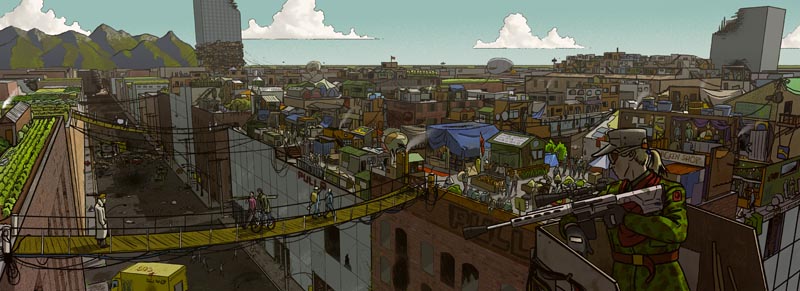Red Markets takes place in the near-future, amidst a doomsday-in-progress.
When the tired joke of the zombie apocalypse clawed its way up from the dirt of the subconscious into terrifying reality, the cultural obsession killed as many as it saved. Some knew to aim for the head … but just as many denied death’s existence until it tore them to pieces. The media, forgetting their own history of click-bait bullshit, screamed “zombies!” and were ignored in turn. When the warnings weren’t wrong, they weren’t believed. “The Romero Effect” dragged the slaughter on for months, until the end seemed certain.
But capitalism loves a good disaster. Our logistics system saved us, and our apocalypse, like everything else, was unevenly distributed.
Five years after the Crash, humanity has survived by leaving itself behind. The world is now divided: infected and clean, living and dead, haves and have-nots, The Recession and The Loss.
Takers live in the Loss, the wrong-side of that divide. They’re trapped in a world where even the apocalypse offers no escape from the everyday grind. It’s a world where combating nightmares becomes another item on the to-do list, where all the luxuries of an old reality taunt you from behind a fence. In the Loss, going to hell and going to work are one and the same. The mundane threats of poverty join ranks with actual monsters, and they all seek to consume you.
- Economic Horror: The life of the average RPG hero would be a nightmare of terror and uncertainty. In Red Markets, danger isn’t sought out; it is farmed to prevent starvation. Every group of characters has a unifying financial motivation baked in from the start, and their heroism is that much more noble for constantly threatening to tip over into greed.
- The Hustle: A bite is deadly, but so is risking it for too little reward. Characters must negotiate for uncertain compensation every session, placing as much weight on subtle, social actions as combat skills.
- The Blight: The disease which creates the setting’s monsters is of unknown origin, inscrutable matter, and mysterious design. Most of the infected are slow and dumb, but they all start out as sprinting, tool-using cannibals. Sometimes it creates Aberrants that defy physics, biology, and every other one of God’s laws. A few people are mysteriously immune, while others become asymptomatic plague carriers. Much of Red Markets’ supernatural terror comes from the unknown, and this allows gamemasters ample room to cater the setting to their needs and keep encounters fresh.
- Diverse Competition: Sometimes zombies are the best-case scenario. Characters are just as likely to encounter more insidious foes, such as rogue political factions, eschatology cults, rival crews, and spies from the Recession.
- Intrigue: The Loss is the new frontier. Every government and corporation has its agents infiltrating the survivors, maneuvering to stake claims for the day the quarantine ends. Characters must decide whether to resist these land-grabbers or hire themselves out to their deep pockets.
- Pirate Culture: Players are encouraged to do anything and everything that might keep the kids fed and the zeds dead. Scavenging goods, performing services, running small businesses, speculative investment – Red Markets features plot hooks and rules for whatever mode of economic production the group thinks might help them survive.
- Inclusive Characters: The institutions of the old world picked favorites when rescuing their citizens. Those from the margins of society were disproportionately abandoned: minorities, genders, orientations, and beliefs society would rather forget. But The Loss only discriminates against the unprofitable, and the near-extinction of humanity may bring about a more just world in the long run … if the characters have the will to build it.
- Near-future Flexibility: No luddite lasts long in the Red Markets. Successful Takers scout zombie hordes with drones and use robotic walkers to carry their loot. They negotiate for jobs over super-cooled wi-fi internet servers suspended on weather balloons and trade in crypto currency. They replace their gnawed off limbs with prosthetic arms capable of crushing skulls. If there’s a working prototype in the real-world, it exists in Red Markets and can be used in the fight.
- Profiteers or Saviors: Depending on who you ask, Takers got their names from undertakers – people who make it their job to dispose of the dead – or as just a synonym for thieves. Are they no more than sociopaths exploiting tragedy for their own gain? The reputation a crew lives up to depends on the characters, but heroism has a price. How much can they afford?



